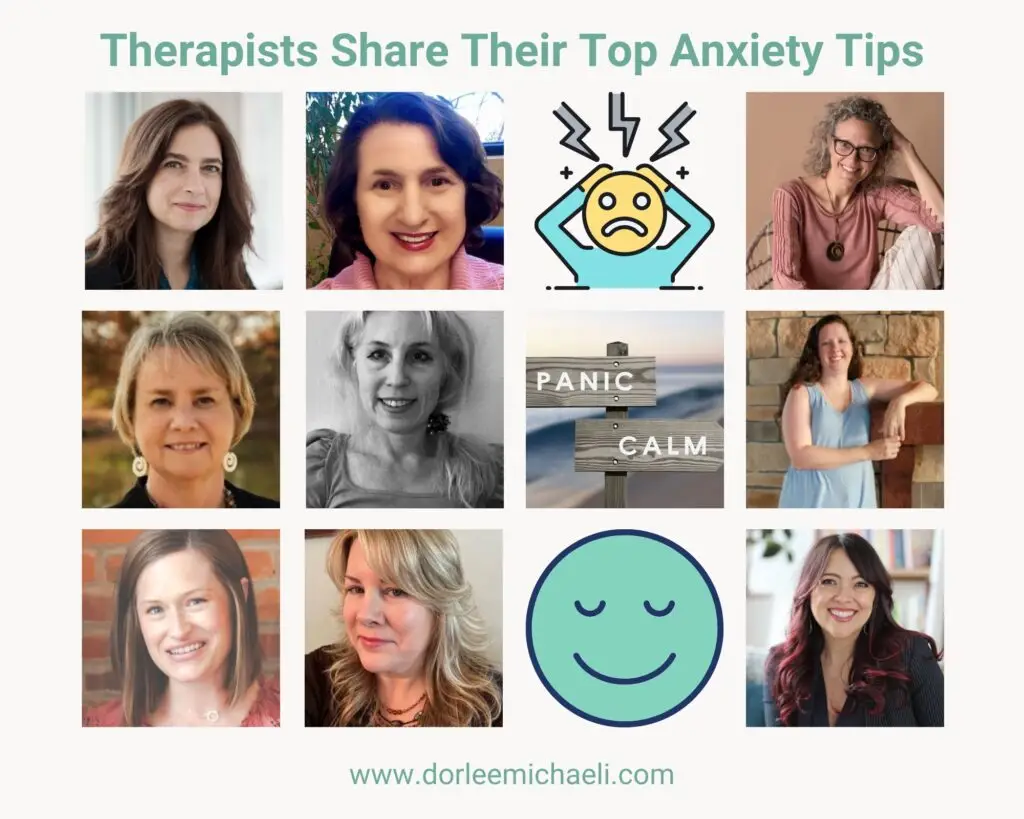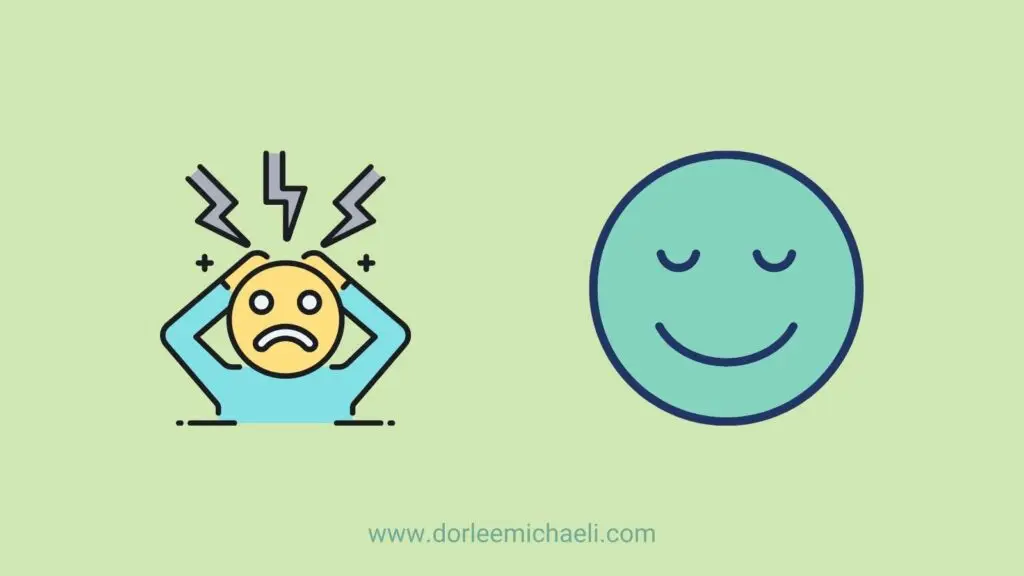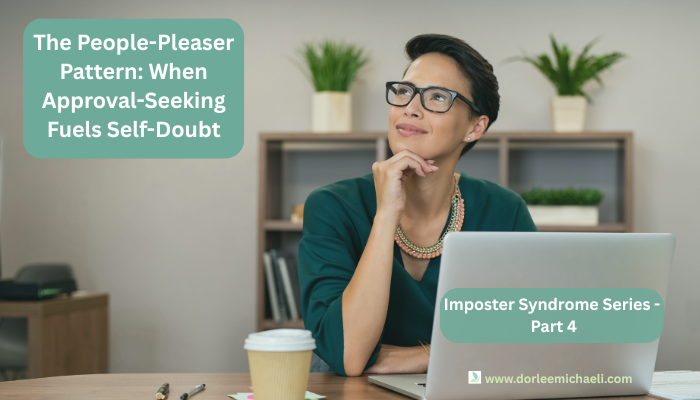
10 different WAys to stop a panic attack
If you’ve ever wondered how to stop a panic attack, you know it can feel impossible in the moment. Your heart races, your breathing gets shallow, and your mind spirals with fear. But panic attacks are survivable, and therapists have proven strategies to help you calm your body and regain control.
Below are several easy breathing, grounding and taking action strategies to stop an anxiety attack or negative thought loop in its track recommended by 10 experienced therapists (9 colleagues and I), a few of whom are also authors and/or university instructors.
I’m so grateful to be able to share learnings from Abby Claeys, LPC, Cora McNeese Nelson, LMHC, Ellen Alesia Nordick, LCMHC, LCAS-A, Erlene Grise-Owens, EdD, LCSW, Hilary Jacobs Hendel, LCSW, Ili Rivera Walter, PhD, LMFT, Sharon Martin, LCSW, Tanya J. Peterson, NCC, and Zar Getz, LCSW! (Note that the order of the photos in the above graphic follows the order of the content.)
One caveat that I’d like to make is that while the methods described in this post are likely to be of help, therapy and sometimes medication may be warranted for individuals with a diagnosis of anxiety. Therapy can be helpful self-care to most of us and is particularly effective in understanding and addressing the root causes of your anxiety.
Quick Summary: 10 Ways to Stop a Panic Attack Fast
✔️ Belly breathing
✔️ Box breathing + mantra
✔️ Mindfulness in the moment
✔️ Gratitude + journaling
✔️ 5-4-3-2-1 grounding
✔️ Reset breathing / mini-vacation visualization
✔️ Body scan
✔️ Take action (write it down, delegate, plan)
✔️ Touch, move, breathe
✔️ Ice hack + reframing
Below, you’ll find therapist-backed explanations and step-by-step instructions for each strategy.
Why having a panic attack can feel so scary
Before delving into the strategies for stopping a panic attack, Hilary Jacobs Hendel, LCSW, psychotherapist and author of “It’s Not Always Depression,” shares some good-to-know info about what is happening in your body during a panic attack:
- Adrenaline is released into the bloodstream.
- Because of adrenaline, the heart beats faster and breathing becomes shallow and harder.
- It’s a scary experience, so if a person doesn’t understand what is happening, they may fear they are having a heart attack and will die.
- It’s not a heart attack.
- We don’t die from panic attacks.
- The body will return to a normal state after the adrenaline is metabolized, which takes several minutes.
- The worst that happens is that you faint and then start breathing normal again.
belly breathing strategy to stop an anxiety attack
Jacobs Hendel states that the best thing to do during a panic attack is to “shift into bellying breathing.” This is because a panic attack occurs “when your brain is triggered to fear and then squirts adrenaline into the bloodstream which causes the rapid breathing and heart rate.” Belly breathing “accelerates calming of the body by stimulating the vagus nerve. See the below video clip for Jacobs Hendel’s demonstration of belly breathing.
BReathing and Mantra method to interrupt a panic attack
Sharon Martin, LCSW, therapist and author of “The CBT Workbook for Perfectionism,” states: “When I feel anxious, I pay attention to my breathing. Taking slow, deep breaths relaxes my body and centers me in the here-and-now. I like to use the Breathing Bubble in the Calm app. But box breathing (breathe in for 4 seconds, hold for 4, exhale for 4, and hold for 4) and other breathing exercises work well, too.”
“A simple mantra, such as, “This will pass” or “I can handle this”, remind Sharon Marin that she can cope and that she’ll get through this difficult time. “Many years ago, I read that most panic attacks will peak soon after they begin and dissipate in about 20 minutes. That’s stayed with me—and feels comforting when I’m afraid that a panic attack will never end. Chronic anxiety, of course, can last much longer. But it, too, has peaks and valleys and the intensity is likely to decrease to a manageable level when people use the coping strategies that usually work for them.”
mindfulness approach to stopping an anxiety attack
To tackle panic attacks or negative thought spirals, psychotherapist and author of “Mindfulness Journal for Depression,” Tanya J. Peterson, NCC‘s favorite approach is to use “mindfulness in the exact moment of a thought spiral or panic attack. It’s counterintuitive, but it is the quickest and most lasting way to truly stop the mind from spiraling downward into thoughts and experiences you don’t want to have.”
Peterson explains how “being mindful means being fully present and aware of what is happening in this moment no matter what that moment brings. It is very centering and grounding. No matter how intense anxiety or panic, it is only one component of a moment. By breathing slowly and deeply and using our senses to focus on something else in that moment, something neutral or even pleasing, we instantly redirect the mind’s attention and teach it that we can choose what we pay attention to.”
“While they feel very real, thoughts are not reality and aren’t always accurate. When we pay attention them, we fuel the fires of anxiety and panic. But when we redirect our attention to something tangible and external to us, we shift our thoughts. This, in turn, calms the nervous system, switching it out of the sympathetic nervous system’s fight-flight-or-freeze reaction and activating the parasympathetic nervous system’s rest-and-digest response, ending the panic attack or anxious thought spiral.”

mindfulness, gratitude and journaling strategy
As part of her long-standing self-care practice, Erlene Grise-Owens, EdD, LCSW, lead co-editor of “The A-to-Z Self-Care Handbook for Social Workers and Other Helping Professionals,” [affiliate link] provides us with her checklist of strategies to stop an anxiety spiral.
- First, with self-compassion, I acknowledge that I’m feeling anxious and that it’s understandable.
- Then, I notice my “self-talk” and body—which is likely negative and tense.
- Next, with mind-body connection, I take grounding breaths.
- Also, I remind myself that my mind believes what it’s told.
- So, with intentionality, I honor factual information contributing to my anxiety and substitute more calming self-talk, instead of the catastrophizing that feeds anxiety. I may voice a positive mantra.
- With my gratitude practice, I often redirect my thoughts by expressing thanks, with specificity.
Usually, these steps stop the spiral. If not, Grise-Owens processes “the anxiety through journaling and/or talking with someone.” She also assesses various components of self-care:
- What’s my caffeine intake?
- How’s my sleep/rest?
- Am I over-consuming social media/news?
- Neglecting yoga and walks?
- Do I need a nature fix?
Sometimes, Grise-Owens uses anxiety to identify actions she can take to address what’s contributing to the anxiety, e.g., political activism, proactive behavior changes, etc. “Anxiety is a message, reminding me that self-care is a lifestyle.”
Mindfulness/Grounding method to stop a panic attack
A quick mindfulness/grounding exercise is Zar Getz, LCSW‘s favorite technique for managing a panic attack in session. She suggests that you look at something that is near you and focus all your attention on it (and if it’s an object, perhaps pick it up).
Getz will then say: “Imagine you are seeing it for the first time. Describe it to me – texture, shape, weight, smell, color, etc. Any details. Now let’s move on to sounds. Close your eyes or look down if that’s more comfortable and name as many different sounds as you can. Now draw your attention to your breathing. Tell me when you can feel the air touch your nostrils. Relax your shoulders. As you inhale, imagine you the air is going throughout your body from your head to your toes. Light and easy. Slowly.”
She might also incorporate some bilateral stimulation (or EMDR) by asking you to slowly alternate hand taps on your chest using the butterfly hug as you’re describing the item that you chose to focus on.
reset breathing and mini-vacation visualization
Cora McNeese Nelson, LMHC recommends you try either her breathing exercise “Reset Breathing“ or visualization grounding technique to address an anxiety attack or rumination loop.
In her “Mini Vacation in a Stressful Situation” video below, she walks you through this process and explains how it’ll help reduce your anxiety and/or stress levels.
McNeese Nelson usually combines these grounding methods with a stress scale. She’ll ask you to rank yourself on a scale of 1-10 [before and after using one of her grounding techniques] so that you can quantify the shift in your anxiety. “1” is totally calm and “10” is most distressed.” For example, “10” is Headed to the hospital feeling like you are having a heart attack or can’t breathe at all.”
body scan tool
Abby Claeys, LPC encourages clients to try to get out of their head (away from the thoughts) and into their body, when stuck in their anxiety.
She says that “we can do this by completing a quick body scan, locating where the anxiety is in the body and then breathing into those areas. Utilizing a breathing visual and/or an aroma to guide the breath can be a helpful way to send peace and calm to that area. This helps calm the limbic system and allows for a different perspective when revisiting the initial anxiety provoking thoughts.”
Here is a script for a body scan from the Veteran’s Affairs.
taking action Method to stop an anxiety attack
Ellen Alesia Nordick, LCMHC, LCAS-A‘s favorite tip to address anxiety is to take action such as writing down what’s worrying you, consulting with a friend, identifying resources to help you, or delegating tasks (having some to-dos helps keep the focus on the solution rather than the problem).
“In real life we don’t always have time to meditate or do yoga, but we can usually find a few minutes to make some notes. When we write it down, we don’t have to keep it in our heads, and this can free up some mental energy that we can use to find a solution to whatever’s bothering us.”
Wondering why writing down helps? As Alesia Nordick explains, “Writing it down allows clients to externalize the worry. This way they don’t feel like they have to worry about remembering it. The act of writing it down helps them to gain some objectivity. Also when they write it down then they can start brainstorming some solutions to the problem.”
Alesia Nordick also suggests that “you can write your concerns in your planner and make an appointment to give it your complete attention. Another way to use writing is to “put it to bed” or in an envelope to deal with later.”
Lastly, “asking yourself, “What do I want to happen?” and/or “What do I need?” also gives the brain a task to complete instead of having racing thoughts.”
Touch, Move, Breathe strategy
Ili Rivera Walter, PhD, LMFT, therapist, writer and professor, recommends employing the TMB: Touch, Move, Breathe method for stopping an anxious thought spiral.
As Rivera Walter describes, “Touch” refers to initiating a moment of physical touch with a safe person who is nearby. A friend, or partner, will help you emotionally regulate, if you hold their hand, or receive a hug. The touch will inspire a feeling of connection, and will therefore generate safety.”
““Move” refers to leaving the spot where the anxiety was triggered. Pacing, changing rooms, or going outside can help interrupt the thought spiral, by shifting your environment. Dancing to a favorite, or designated, song is a go-to strategy for thought spirals, because it automatically stops anxious overthinking through enjoyment and physicality.”
Lastly, Rivera Walter explains that “breathing slows down anxiety, by moving your focus from fear, or your mind, to your body. Through breathing you are reminded that you are safe, because your body is showing up for you at its most basic level—the breath.”

5-4-3-2-1, ICE HACK AND REFRAMING METHODS
Lastly, I (Dorlee Michaeli) recommend employing either the 5-4-3-2-1 grounding technique, the ice hack or the reframing method for stopping a panic attack, or interrupting an unhelpful thought loop.
The 5-4-3-2-1 approach (click link for free download) involves focusing on looking around and focusing on using your 5 senses to help you feel grounded and see that you are safe. When you feel safe, the thinking part of the brain is able to return and function well.
The ice hack entails going into your freezer (if you’re home) or buying a cold drink (if you’re out and about) and literally holding onto one or more ice cubes. This will divert your brain from rumination or your panic attack trigger to focusing on the intense coldness in your hand, thereby enabling your rational part to get back online and help you move forward.
Lastly, the reframing method consists of challenging and rewording a negative statement so that the negative statement can longer stand alone as the last word on the topic at hand. For example, let’s say you often think “I always make mistakes.” A reframe could be “Sometimes I make mistakes and that’s ok. Mistakes help me learn and grow.” Create a cheatsheet of the critical statements that typically haunt you along with positive coping statements to contradict them so as to be prepared for the next negative thought spiral. One of the most powerful shifts is learning to meet yourself with kindness in the middle of panic.
One of the most powerful shifts is learning to meet yourself with kindness in the middle of panic. For more on this, see my post on self-compassion for perfectionists, including how it calms the nervous system and supports lasting resilience. In ongoing trauma-related anxiety, EMDR therapy can help calm the nervous system at its source.
Most people experience some relief within 5-10 minutes, but timing varies.
The grounding techniques (5-4-3-2-1 method, cold water on face) tend to work fastest because they interrupt the panic response directly.
Breathing exercises may take 10-15 minutes. The key: Practice these when you’re calm so your nervous system recognizes them during panic.
It’s like muscle memory for your brain.
Go to the ER if you experience: chest pain that doesn’t ease with breathing, severe shortness of breath, loss of consciousness, or thoughts of harming yourself.
If you’re unsure, it’s always okay to call 911 or go to urgent care.
Panic attacks feel like emergencies, but they’re not dangerous ; however, your safety and peace of mind matter most.
Not necessarily. Many people manage panic attacks effectively with breathing, grounding, and therapy alone.
Others benefit from medication (SSRIs, beta-blockers) alongside therapy.
This is a conversation with your doctor or psychiatrist.
There’s no one-size-fits-all answer. The techniques in this post work whether or not you’re on medication.
Panic attacks typically include: racing heart, shortness of breath, dizziness, tingling, fear of dying, and come on suddenly.
Heart attacks may include: chest pressure, pain radiating to arm/jaw, nausea, and often happen during exertion.
When in doubt, get checked by a doctor.
It’s better to be safe, and ruling out medical causes gives you peace of mind.
Many people with panic disorder worry about this. You’re not alone.
No. Panic attacks are uncomfortable and scary, but they’re not dangerous.
Your body is having a false alarm response. It feels like an emergency, but physically, you’re safe.
The panic will peak and then naturally come down. Understanding this can actually help reduce panic over time.
First, give them time – panic can take 15-20 minutes to subside naturally.
If the techniques aren’t helping after several tries, that’s valuable information for your therapist.
Some people respond better to certain techniques (grounding vs. breathing), and a therapist can help you find what works for your nervous system.
EMDR therapy is also highly effective for panic attacks.
Absolutely. The 5-4-3-2-1 grounding technique is discreet. You can do it while sitting at your desk or in a meeting.
Breathing exercises look natural.
Cold water on your face might require a bathroom break, but that’s doable.
The key: Practice at home first so you’re confident using them in public.
Published September 19, 2021; Last updated: Dec 16, 2025

Need some one-on-one assistance to help you cope with your feelings of stress, anxiety or overwhelm? Please reach out to schedule a free consultation.


![Read more about the article Grounding Techniques: 12 Ways to Calm Anxiety Fast [Free Download]](https://dorleemichaeli.com/wp-content/uploads/2021/05/12-Grounding-Techniques-for-Anxiety-768x439.webp)


Pingback: Grounding Techniques: 12 Ways to Calm Anxiety Fast [Free Download]